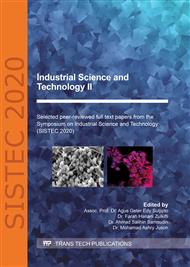[1]
J. Kim, R. Kumar, A.J. Bandodkar, J. Wang, Advanced materials for printed wearable electrochemical devices: A review, Advanced Electronic Materials 3(1) (2017) 1600260.
DOI: 10.1002/aelm.201600260
Google Scholar
[2]
A.J. Bandodkar, W. Jia, J. Wang, Tattoo‐based wearable electrochemical devices: a review, Electroanalysis 27(3) (2015) 562-572.
DOI: 10.1002/elan.201400537
Google Scholar
[3]
J.A. Hondred, I.L. Medintz, J.C. Claussen, Enhanced electrochemical biosensor and supercapacitor with 3D porous architectured graphene via salt impregnated inkjet maskless lithography, Nanoscale Horizons 4(3) (2019) 735-746.
DOI: 10.1039/c8nh00377g
Google Scholar
[4]
M. Hafiza, M. Isa, Correlation between structural, ion transport and ionic conductivity of plasticized 2-hydroxyethyl cellulose based solid biopolymer electrolyte, Journal of Membrane Science 597 (2020) 117176.
DOI: 10.1016/j.memsci.2019.117176
Google Scholar
[5]
M. Chai, M. Isa, The oleic acid composition effect on the carboxymethyl cellulose based biopolymer electrolyte, (2013).
Google Scholar
[6]
L. Sampathkumar, P.C. Selvin, S. Selvasekarapandian, P. Perumal, R. Chitra, M. Muthukrishnan, Synthesis and characterization of biopolymer electrolyte based on tamarind seed polysaccharide, lithium perchlorate and ethylene carbonate for electrochemical applications, Ionics 25(3) (2019) 1067-1082.
DOI: 10.1007/s11581-019-02857-1
Google Scholar
[7]
R. Singh, J. Baghel, S. Shukla, B. Bhattacharya, H.-W. Rhee, P.K. Singh, Detailed electrical measurements on sago starch biopolymer solid electrolyte, Phase Transitions 87(12) (2014) 1237-1245.
DOI: 10.1080/01411594.2014.944911
Google Scholar
[8]
Y.A. Salman, O.G. Abdullah, R.R. Hanna, S.B. Aziz, Conductivity and electrical properties of chitosan-methylcellulose blend biopolymer electrolyte incorporated with lithium tetrafluoroborate, Int. J. Electrochem. Sci 13 (2018) 3185-3199.
DOI: 10.20964/2018.04.25
Google Scholar
[9]
I. Vroman, L. Tighzert, Biodegradable polymers, Materials 2(2) (2009) 307-344.
Google Scholar
[10]
M. Saadiah, Y. Nagao, A. Samsudin, Proton (H+) transport properties of CMC–PVA blended polymer solid electrolyte doped with NH4NO3, International Journal of Hydrogen Energy (2020).
DOI: 10.1016/j.ijhydene.2020.03.213
Google Scholar
[11]
A. Samsudin, M. Isa, Structural and electrical properties of carboxy methylcellulose-dodecyltrimethyl ammonium bromide-based biopolymer electrolytes system, International Journal of Polymeric Materials 61(1) (2012) 30-40.
DOI: 10.1080/00914037.2011.557810
Google Scholar
[12]
A. Zulkifli, M. Saadiah, N. Mazuki, A. Samsudin, Characterization of an amorphous materials hybrid polymer electrolyte based on a LiNO3-doped, CMC-PVA blend for application in an electrical double layer capacitor, Materials Chemistry and Physics (2020) 123312.
DOI: 10.1016/j.matchemphys.2020.123312
Google Scholar
[13]
W. Zhan, Y. Yuan, H. Yi, S. Song, C. Liu, Hydrophobic agglomeration of montmorillonite fines in aqueous solutions induced by dodecyl trimethyl ammonium bromides, Chemical Physics Letters 739 (2020) 136999.
DOI: 10.1016/j.cplett.2019.136999
Google Scholar
[14]
H. Liu, P. Yuan, D. Liu, H. Bu, H. Song, Z. Qin, H. He, Pyrolysis behaviors of organic matter (OM) with the same alkyl main chain but different functional groups in the presence of clay minerals, Applied Clay Science 153 (2018) 205-216.
DOI: 10.1016/j.clay.2017.12.028
Google Scholar
[15]
P.A.B. Ranjana, S. Jeya, S. Abarna, M. Premalatha, A. Arulsankar, B. Sundaresan, Enhancement of Na+ ion conduction in polymer blend electrolyte P (VdF-HFP)–PMMA-NaTf by the inclusion of EC, Journal of Polymer Research 26(2) (2019) 38.
DOI: 10.1007/s10965-019-1704-x
Google Scholar
[16]
M.N. Hafiza, M.I.N. Isa, Correlation between structural, ion transport and ionic conductivity of plasticized 2-hydroxyethyl cellulose based solid biopolymer electrolyte, Journal of Membrane Science 597 (2020) 117176.
DOI: 10.1016/j.memsci.2019.117176
Google Scholar
[17]
V. Moniha, M. Alagar, S. Selvasekarapandian, B. Sundaresan, G. Boopathi, Conductive bio-polymer electrolyte iota-carrageenan with ammonium nitrate for application in electrochemical devices, Journal of Non-Crystalline Solids 481 (2018) 424-434.
DOI: 10.1016/j.jnoncrysol.2017.11.027
Google Scholar
[18]
K.M.G. Francis, S. Subramanian, K. Shunmugavel, V. Naranappa, S.S.M. Pandian, S.C. Nadar, Lithium ion-conducting blend polymer electrolyte based on PVA–PAN doped with lithium nitrate, Polymer-Plastics Technology and Engineering 55(1) (2016) 25-35.
DOI: 10.1080/03602559.2015.1050523
Google Scholar
[19]
K. Sundaramahalingam, D. Vanitha, N. Nallamuthu, A. Manikandan, M. Muthuvinayagam, Electrical properties of lithium bromide poly ethylene oxide/poly vinyl pyrrolidone polymer blend elctrolyte, Physica B: Condensed Matter 553 (2019) 120-126.
DOI: 10.1016/j.physb.2018.10.040
Google Scholar
[20]
A. Fuzlin, N. Bakri, B. Sahraoui, A. Samsudin, Study on the effect of lithium nitrate in ionic conduction properties based alginate biopolymer electrolytes, Materials Research Express 7(1) (2019) 015902.
DOI: 10.1088/2053-1591/ab57bb
Google Scholar


